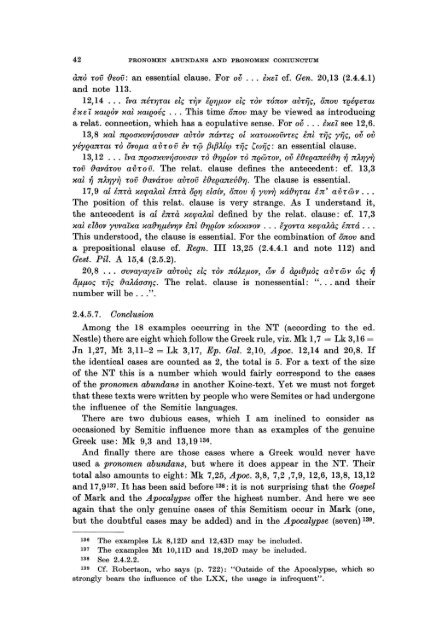Pronomen Abundans and Pronomen Coniunctum. A ... - DWC
Pronomen Abundans and Pronomen Coniunctum. A ... - DWC
Pronomen Abundans and Pronomen Coniunctum. A ... - DWC
You also want an ePaper? Increase the reach of your titles
YUMPU automatically turns print PDFs into web optimized ePapers that Google loves.
42 PRONOMEN ABUNDANS AND PRONOMEN CONIUNCTUM<br />
à.nà 'Wv {}WV: an essential clause. For OV ... è"û cf. Gen. 20,13 (2.4.4.1)<br />
<strong>and</strong> note ll3.<br />
12,14 ... lva né-rrrrat elç riJv le'YJflOV elç .àv .ónov aviijç, onov .eüpeiat<br />
è" ei "ateàv "ai "ateOVç ... This time onov may be viewed as introducing<br />
arelat. connection, which has a copulative sense. For ov ... è"û see 12,6.<br />
13,8 "ai neoO""vv~O"ovO"w av.àv návuç Ol "aiOt"OVvuç èni .ijç yijç, ov ov<br />
yéyeaniat .à ovofla av.ov èv np fJtfJJ.üp .ijç Cwijç: an essential clause.<br />
13 12 " , ' .0.' I - T '.0. '.CL,,' 1 I<br />
, ... wa ne0O""vv'YJO"ovO"tV .0 'lf'YJelOV .0 new.ov, ov e'lfeeanevv'l 'YJ n/l'YJJ!'YJ<br />
.ov {}avá.ov av.ov. The relat. clause defines the antecedent : cf. 13,3<br />
"ai ij nJ.'YJY~ .ov {}avá.ov av.ov è{}eeanev{}r;. The clause is essential.<br />
17,9 ai ln.à "ecpaJ.ai ln.à oe'YJ elO"{v, onov ij yvvi] "á{}'YJiat è n' a v. w v ...<br />
The position of this relat. clause is very strange. As I underst<strong>and</strong> it,<br />
the antecedent is ai èn.à xecpaJ.ai defined by the relat. clause: cf. 17,3<br />
'l~ ~ .CL,,' ".0." " 1 '<br />
"<br />
"at e uOv yvvat"a "av'lflEY'YJV ent 'lf'YJelOV "o,,"wov ... exov.a "ecpa/laç en.a ...<br />
This understood, the clause is essential. For the combination of onov <strong>and</strong><br />
a prepositional clause cf. Regn. III 13,25 (2.4.4.1 <strong>and</strong> note ll2) <strong>and</strong><br />
Gest. Pil. A 15,4 (2.5.2).<br />
20,8 ... O"vvayayeïv av.ovç elç .àv nóJ.eflov, wv ó àet{}flàç av.wv wç ij<br />
uflflOÇ .ijç {}aJ.áO"O"'YJç.<br />
number will be ...".<br />
The relat. clause is nonessential: " ... <strong>and</strong> their<br />
2.4.5.7. Conclusion<br />
Among the 18 examples occurring in the NT (according to the ed.<br />
NestIe) there are eight which follow the Greek rule, viz. Mk 1,7 = Lk 3,16 =<br />
Jn 1,27, Mt 3,ll-2 = Lk 3,17, Ep. Gal. 2,10, Apoc. 12,14 <strong>and</strong> 20,8. If<br />
the identical cases are counted as 2, the total is 5. For a text of the size<br />
of the NT this is a number which would fairly correspond to the cases<br />
of the pronomen ribundans in another Koine-text. Yet we must not forget<br />
that these texts were written by people who were Semites or had undergone<br />
the influence of the Semitic languages.<br />
There are two dubious cases, which I am inclined to consider as<br />
occasioned by Semi tic influence more than as ex am pIes of the genuine<br />
Greek use: Mk 9,3 <strong>and</strong> 13,19 136 .<br />
And finally there are those cases where a Greek would never have<br />
used a pronomen abundans, but where it does appear in the NT. Their<br />
total also amounts to eight: Mk 7,25, Apoc. 3,8, 7,2 ,7,9, 12,6, 13,8, 13,12<br />
<strong>and</strong> 17,9 137 . It has been said before 138: it is not surprising that the Gospel<br />
of Mark <strong>and</strong> the Apocalypse offer the highest number. And here we see<br />
again that the only genuine cases of this Semitism occur in Mark (one,<br />
but the doubtful cases may be added) <strong>and</strong> in the Apocalypse (seven) 139.<br />
136 The examples Lk 8,12D <strong>and</strong> 12,43D may be included.<br />
137 The examples Mt 10,llD <strong>and</strong> 18,20D may be included.<br />
138 See 2.4.2.2.<br />
139 Cf. Robertson, who says (p. 722): "Outside of the Apocalypse, which so<br />
strongly bears the inftuence of the LXX, the usage is infrequent".
















